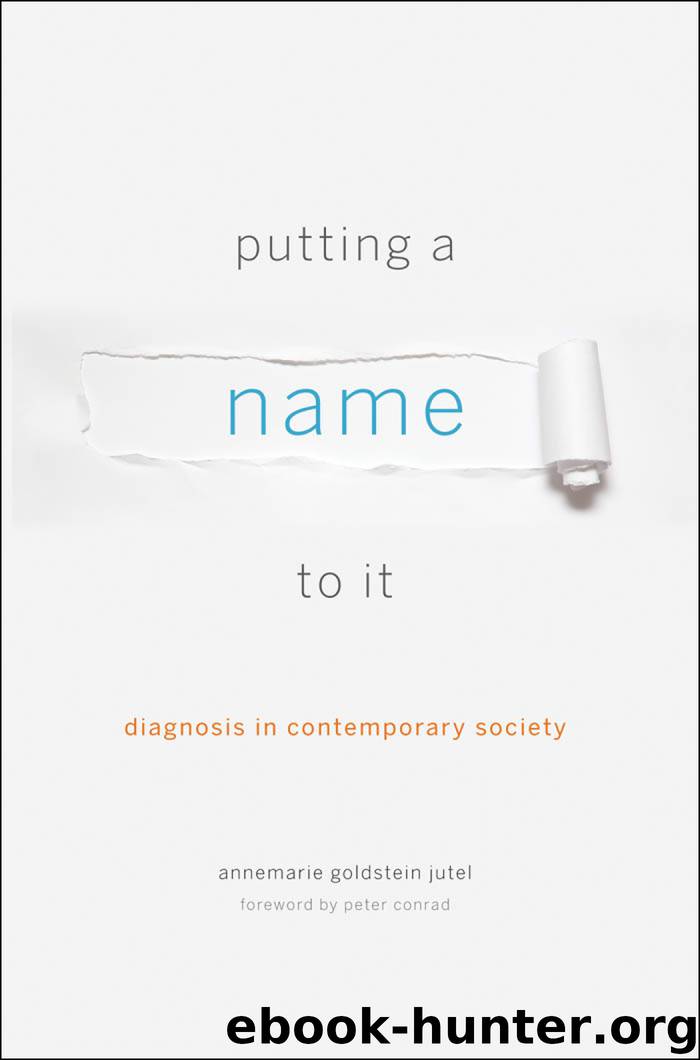Putting a Name to It by Annemarie Goldstein Jutel

Author:Annemarie Goldstein Jutel
Language: eng
Format: epub
Publisher: Johns Hopkins University Press
Published: 2011-04-04T04:00:00+00:00
Psychiatry to Explain the Unexplainable
Rosenberg (2006) writes that “psychiatry is the residuary legatee of . . . developments that have always been contested at the ever-shifting boundary between disease and deviance, feeling and symptom, the random and the determined, the stigmatized and the value-free” (p. 237). He seeks here to account for how disease categories explain behavior and emotional pain. This is relevant to the issue of medically unexplained symptoms, as the seemingly unjustified symptoms are “behaviors” in a model that uses psychiatry to explain the unexplained. This psychiatric domiciliation of the unexplained is problematic because it frequently relies on diagnosis by exclusion (settled on by ruling out other explanations), fails to acknowledge the limitations of knowledge, and shifts responsibility for cause and cure in a way that ignores sociohistorical realities.
First, considering medically unexplained symptoms a psychiatric disorder is a diagnosis by exclusion. In other words, it is a diagnosis made not on the basis of what it is but on the basis of what it is not. The absence of explanation, rather than the presence of a well-defined feature, defines the condition. The label becomes a wastebasket diagnosis—a classification in which may be placed many conditions that don’t easily fit elsewhere. As Robins and Helzer (1986) point out, psychiatric diagnosis is already challenged by the absence of definitive tests to mark the presence of a disorder; there is no equivalent to the x-ray of orthopedics or the hemoculture of infectious disease. It is therefore difficult to establish a positive diagnosis yet facile to attach a positive psychiatric diagnosis to a medical patient.
Second, this assumption of psychiatric disorder in the absence of other diagnoses presumes the infallibility of the doctor and of the field. And yet one postmortem study revealed errors of diagnosis in 39 percent of major diagnoses and 50 percent of less serious diagnoses (Aalton, Samson, and Jansen 2006). Numerous diagnostic errors can be retrospectively assigned to an incomplete knowledge of the field. For example, Lyme disease, before its designation as a specific diagnosable entity, was often cast as atypical rheumatoid arthritis (Graber, Gordon, and Franklin 2002); multiple sclerosis was frequently diagnosed as a psychiatric disorder, possibly because of the subjective nature of many early symptoms (Skegg, Corwin, and Skegg 1988). Symptoms may also be atypical, presenting challenges for clinician and patient alike (Malterud and Taksdal 2007).
Advances in genetic understandings of illness provide links between pathologies that were previously seen as completely distinct (F. Miller et al. 2006). As Kirmayer et al. (2004) state, “The lack of explanation reflects the limits of medical knowledge, available technology and the epistemological difficulties of assigning a clear cause to subjective complaints like pain and fatigue, which may have no objectively measurable correlates and may change rapidly over time in quality and intensity” (p. 663).
Third, this approach to the unexplained symptom shifts responsibility (for the inability to explain the symptom) from the doctor to the patient, positing the cause as the patient’s mental health. Hadler (1996) reflects on both causes and limitations
Download
This site does not store any files on its server. We only index and link to content provided by other sites. Please contact the content providers to delete copyright contents if any and email us, we'll remove relevant links or contents immediately.
| Administration & Medicine Economics | Allied Health Professions |
| Basic Sciences | Dentistry |
| History | Medical Informatics |
| Medicine | Nursing |
| Pharmacology | Psychology |
| Research | Veterinary Medicine |
Periodization Training for Sports by Tudor Bompa(8170)
Why We Sleep: Unlocking the Power of Sleep and Dreams by Matthew Walker(6618)
Paper Towns by Green John(5089)
The Immortal Life of Henrietta Lacks by Rebecca Skloot(4525)
The Sports Rules Book by Human Kinetics(4294)
Dynamic Alignment Through Imagery by Eric Franklin(4116)
ACSM's Complete Guide to Fitness & Health by ACSM(3989)
Kaplan MCAT Organic Chemistry Review: Created for MCAT 2015 (Kaplan Test Prep) by Kaplan(3939)
Introduction to Kinesiology by Shirl J. Hoffman(3725)
Livewired by David Eagleman(3683)
The Death of the Heart by Elizabeth Bowen(3551)
The River of Consciousness by Oliver Sacks(3540)
Alchemy and Alchemists by C. J. S. Thompson(3449)
Bad Pharma by Ben Goldacre(3356)
Descartes' Error by Antonio Damasio(3230)
The Emperor of All Maladies: A Biography of Cancer by Siddhartha Mukherjee(3065)
The Gene: An Intimate History by Siddhartha Mukherjee(3047)
The Fate of Rome: Climate, Disease, and the End of an Empire (The Princeton History of the Ancient World) by Kyle Harper(3003)
Kaplan MCAT Behavioral Sciences Review: Created for MCAT 2015 (Kaplan Test Prep) by Kaplan(2936)
